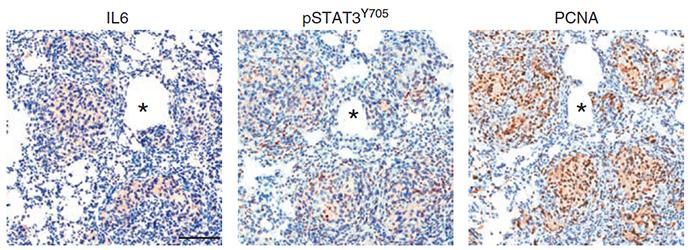An immune system marker for therapy-resistant prostate cancer

In RApidCaP, a mouse model of human metastatic prostate cancer that they developed, Trotman and colleagues have identified an immune system marker that may help to distinguish patients who will and will not respond to hormone therapy. That marker is IL-6, an immune system component whose presence is indicated in brown patches in the image at left, in a section of lung tissue (blue) colonized by prostate cancer cells. The middle image of the same section of lung tissue indicates activation of STAT3, a protein that is the downstream target of IL-6 signaling. The image at right of the same tissue section demonstrates the presence of PCNA in the invading prostate cells, a marker of metastasis. Courtesy of Trotman Lab/ CSHL
You are a patient who has just been treated for a serious illness but neither you nor your doctor knows how likely it is that you — in comparison with other patients — will actually be helped by the treatment. This is often the situation with prostate cancer, one of the deadliest and most highly prevalent cancers. While hormone therapy can help, patient responses vary widely, and it's still unclear why some types of prostate cancer seem to be resistant to the therapy.
In work published today in Cancer Discovery, a team led by associate professor Lloyd Trotman at Cold Spring Harbor Laboratory (CSHL) shows how signaling by an immune system component called interleukin-6 (IL-6) appears to play an important role in driving particularly aggressive and therapy-resistant prostate cancer.
Our research suggests that IL-6 could be a marker for when the disease switches to a more dangerous state that is ultimately hormone therapy-resistant,' says Trotman.
The results could have important implications for human prostate cancer. 'The gain could be immense, because today's problem is that the variability in response of humans to hormone therapy is amazing,' Trotman says. 'For one man this therapy might be great, might reduce disease burden dramatically for many, many, years, and be an extreme benefit,' he says. 'For others there's almost no response, and it's still not clear to clinicians who is who.'
Being able to predict which patients would benefit from hormone therapy 'would be amazing,' Trotman says. 'We are really hopeful that translating the IL-6 discovery into the clinics could help us stratify patients into good responders and bad responders. For any hospital this would be a major breakthrough.'
Trotman and his team, which included Dawid Nowak, Ph.D., a postdoctoral investigator who is the paper's first author, looked for cellular signals that led to metastasis and hormone therapy resistance in a genetically engineered mouse model for metastatic prostate cancer. They found that the combined loss of two genes, PTEN and p53 — closely associated with prostate cancer metastasis — led to the secretion of IL-6. Signaling by IL-6 was then responsible for activating a powerful cancer gene called MYC, which drives cell proliferation and disease progression.
'It suggested immediately that cell-cell communication is very, very important to make the cells resistant to therapy and very aggressive,' says Trotman.
The involvement of the MYC pathway suggests that it could potentially serve as a target of drugs against prostate cancer, Trotman says. The team's next step is to study IL-6 signaling in humans. 'IL-6 detection in blood has been developed to a high art,' Trotman says. 'There are very good tools, which have been tested in the hospital setting.'
###
The work described in this release was supported by the Pershing Square Sohn Cancer Research Alliance; the American Cancer Society; the National Institutes of Health (CA137050); the Department of Defense (W81XWH-14-1-0247), the STARR Foundation (I8-A8-112), the Robertson Research Fund of CSHL; and the CSHL Cancer Center (through NIH Support Grant 5P30CA045508).
'MYC drives pten/Trp53-deficient proliferation and metastasis due to IL6 secretion and AKT suppression via PHLPP2' appeared online in Cancer Discovery June 3, 2015. The authors are: Dawid G. Nowak, Hyejin Cho, Tali Herzka, Kaitlin Watrud, Daniel V. DeMarco, Victoria M.Y. Wang, Serif Senturk, Christof Fellmann, David Ding, Tumas Beinortas, David Kleinman, Muhan Chen, Raffaella Sordella, John E. Wilkinson, Mireia Castillo-Martin, Carlos Cordon-Cardo, Brian D. Robinson, and Lloyd C. Trotman. The paper can be obtained online at: http://cancerdiscovery.
About Cold Spring Harbor Laboratory
Celebrating its 125th anniversary in 2015, Cold Spring Harbor Laboratory has shaped contemporary biomedical research and education with programs in cancer, neuroscience, plant biology and quantitative biology. Home to eight Nobel Prize winners, the private, not-for-profit Laboratory is more than 600 researchers and technicians strong. The Meetings and Courses Program hosts more than 12,000 scientists from around the world each year on its campuses in Long Island and in Suzhou, China. The Laboratory's education arm also includes an academic publishing house, a graduate school and programs for middle and high school students and teachers. For more information, visit http://www.
Media Contact
All latest news from the category: Health and Medicine
This subject area encompasses research and studies in the field of human medicine.
Among the wide-ranging list of topics covered here are anesthesiology, anatomy, surgery, human genetics, hygiene and environmental medicine, internal medicine, neurology, pharmacology, physiology, urology and dental medicine.
Newest articles

A new puzzle piece for string theory research
Dr. Ksenia Fedosova from the Cluster of Excellence Mathematics Münster, along with an international research team, has proven a conjecture in string theory that physicists had proposed regarding certain equations….

Climate change can cause stress in herring larvae
The occurrence of multiple stressors undermines the acclimatisation strategies of juvenile herring: If larvae are exposed to several stress factors at the same time, their ability to respond to these…

Making high-yielding rice affordable and sustainable
Plant biologists show how two genes work together to trigger embryo formation in rice. Rice is a staple food crop for more than half the world’s population, but most farmers…



